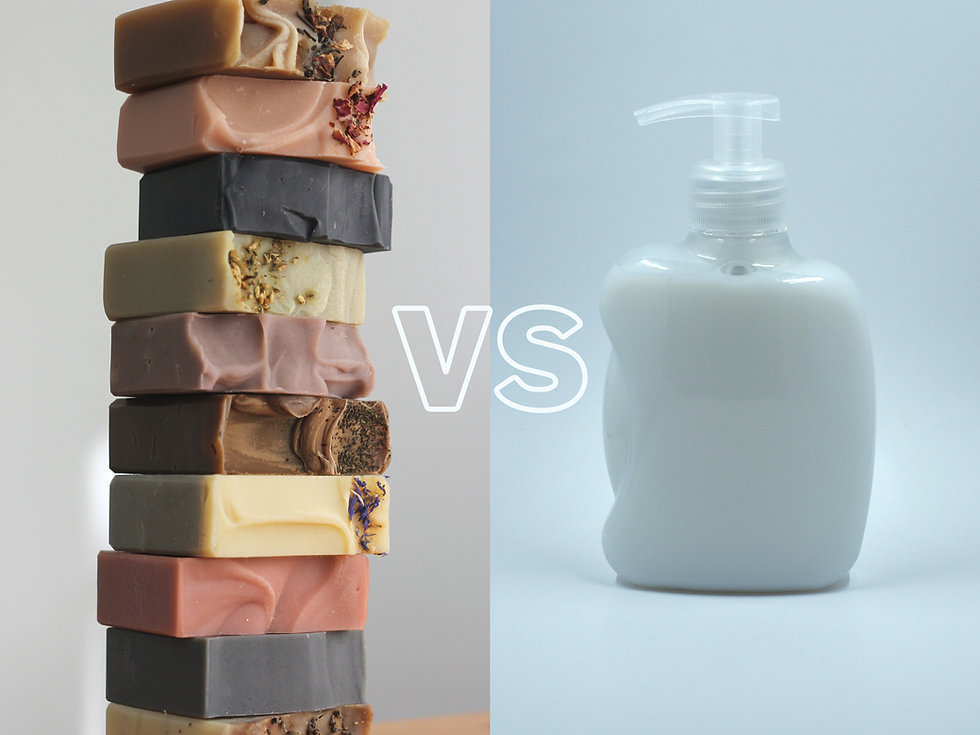The Environmentalist's Perspective: Liquid vs. Bar Soap
- Soro

- Dec 25, 2020
- 2 min read
Updated: Sep 26, 2023
The humble bar of soap has made a grand return to popularity in the latest decade. The 1980s saw a switch in the Western world from bar soap, which had been the commonplace option for centuries, to liquid soap, mass produced in plastic bottles. Now, with a growing interest in sustainability and simplicity, the West is returning to the trusted bar of soap. From reduced emissions to healthier ingredients, bar soap is the greener choice for many reasons.

Lifespan
Studies have shown that we use significantly less bar soap to wash our hands than we do liquid soap. Because you need to rub a soap bar in your hands to create a lather, you tend to take just the amount of soap you need. This is not the case with liquid soap. Soap dispenser manufacturers often make dispensers that portion out more soap than what is actually needed. Presumably, this is to ensure we will be back to buy more sooner rather than later. Researchers at the Zurich Institute of Environmental Engineering found that per average hand-washing, people use 0.35 grams of bar soap vs. 2.3 grams of liquid soap (Koehler and Wildbolz, 2009). This translates to using 6x more liquid soap than bar soap per wash.
Transportation
Liquid soap is largely composed of water. Not only does this make for a less potent product, it also increases shipping emissions due to the added weight of the water. Additionally, liquid soap is usually packaged in cylindrical shaped bottles, making them difficult to stack efficiently for compact transportation. Bars of soap can be packed tightly together during transport, saving space on the transport vehicle, ultimately resulting in fewer delivery trips, thereby reducing fossil fuel emissions.
Packaging materials
Bar soap has the environmental advantage in the packaging department, often having no more than a small paper label and a cardboard box for safe travel. This is in stark contrast to liquid soap, which is packaged in bulky plastic bottles that are generally not recyclable. Furthermore, these plastic bottles require approximately 20x more energy to produce than the paper packaging for their bar soap counterparts. Unfortunately, bottles made with more sustainable materials, such as glass or metal, require even more energy to produce than plastic bottles.
Energy
Overall, liquid soap requires at least 5x more energy to produce than bar soap does.
Ingredients
Liquid soap often contains petroleum-based ingredients, chemical stabilizers, preservatives, parabens, artificial fragrances and colors, and emulsifiers. Many liquid soaps have a toxic effect on the environment and require intensive processing at water treatment facilities to be neutralized, thereby requiring even more water and energy. While bar soaps surge in popularity, we are also seeing an increased interest in biodegradable bar soaps that are significantly healthier for both you and the planet.
From the environmentalist's perspective, bar soap is the clear winner. With so many naturally scented and colored soaps to choose from today, the switch from liquid soaps and body washes to solid soap has never been more enjoyable!
Citations
Koehler, A., & Wildbolz, C. (2009). Comparing the Environmental Footprints of Home-Care and Personal-Hygiene Products: The Relevance of Different Life-Cycle Phases. Environmental Science and Technology, 43(22), 8643-8651.

Comments